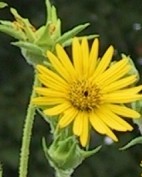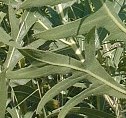 At twelve feet tall and with a taproot that can be fifteen feet long, this native of tall grass prairies is a plant to be taken seriously. Add to its size is the fact that it can live up to 100 years so when you plant this in your garden you may have a companion for life. Both leaves and flowers add to the attractiveness of the plant. Six to thirty yellow disc-shaped flowers are produced on long stems in mid-summer for about one and a half months and look very much like wild sunflowers. The leaves are large and deeply divided, and orient themselves north-south in the bright mid-day sun giving the plant its common name.
At twelve feet tall and with a taproot that can be fifteen feet long, this native of tall grass prairies is a plant to be taken seriously. Add to its size is the fact that it can live up to 100 years so when you plant this in your garden you may have a companion for life. Both leaves and flowers add to the attractiveness of the plant. Six to thirty yellow disc-shaped flowers are produced on long stems in mid-summer for about one and a half months and look very much like wild sunflowers. The leaves are large and deeply divided, and orient themselves north-south in the bright mid-day sun giving the plant its common name.
Type: Herbaceous perennial
Bloom: Yellow flowers, 3-4” across, are borne on elongated stems in mid summer.
 Foliage: Basal leaves 12-24” are broadly lanceolate, covered with fine white hairs and are deeply divided upper leaves are smaller.
Foliage: Basal leaves 12-24” are broadly lanceolate, covered with fine white hairs and are deeply divided upper leaves are smaller.
Size: 6-12’ H x 2-6’ W
Light: Full sun
Soil: Deep loam, moist to slightly dry
Hardiness: Zones 5-9
Care: Low maintainence
Pests and Diseases: None of significance
Propagation: Seed in fall, with moist stratification in spring; division is difficult because of deep root; may take many years to reach blooming size.
Companion plants: Indian grass (Sorghastrum nutans), Big bluestem (Andropogon gerardii), New England aster (Aster novae-angliae), butterfly weed (Asclepias tuberose).
